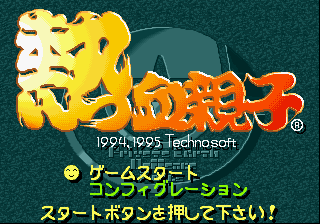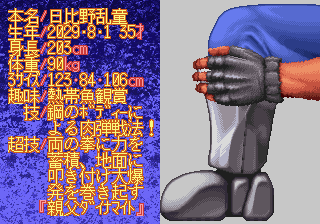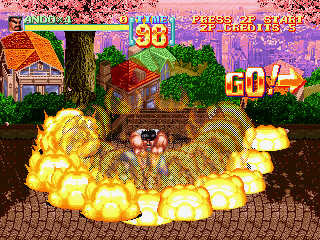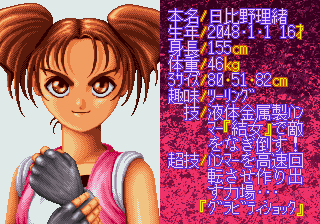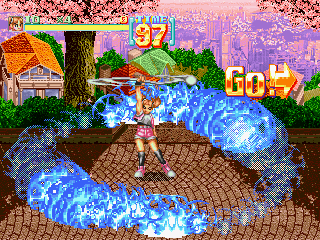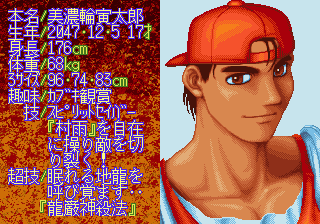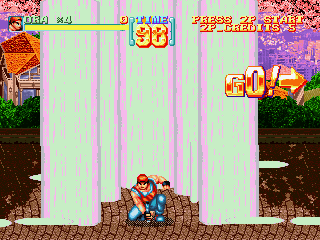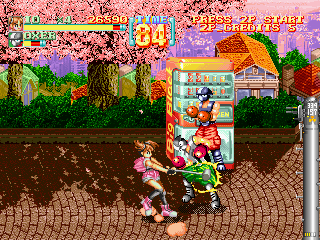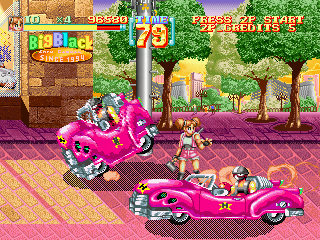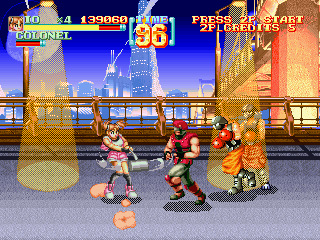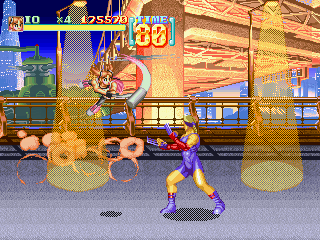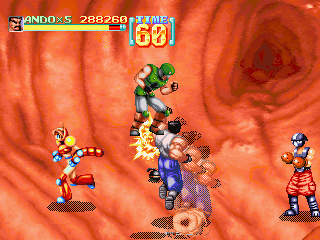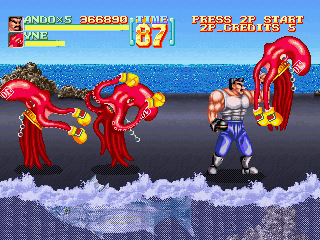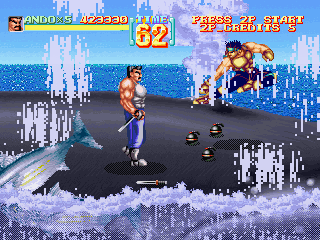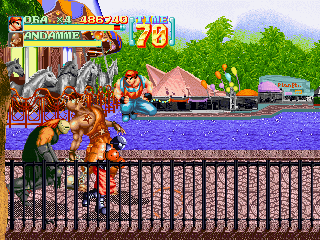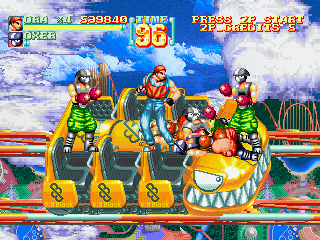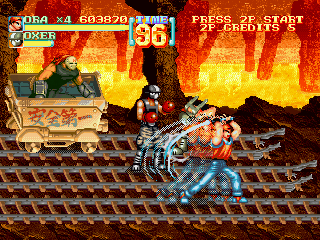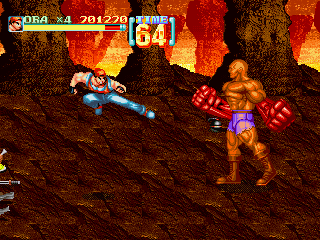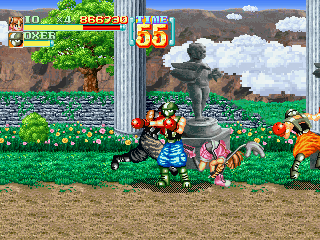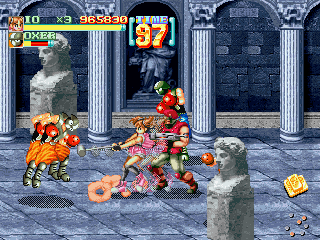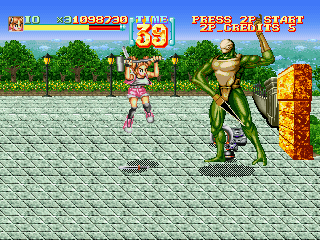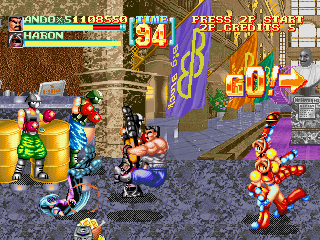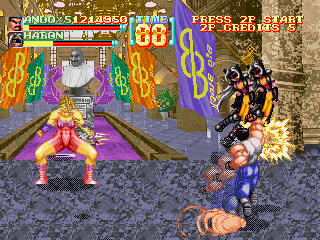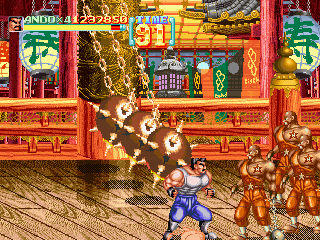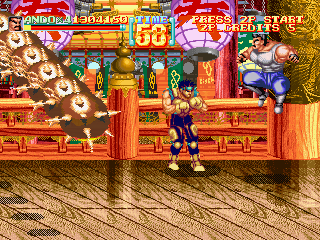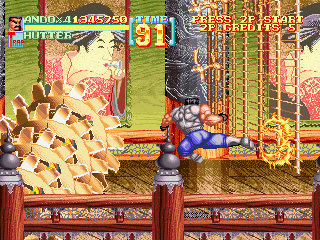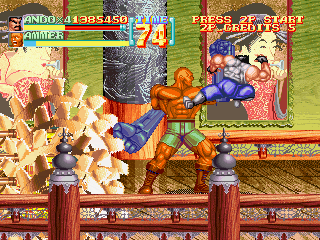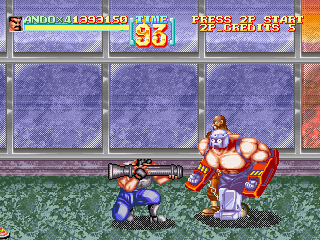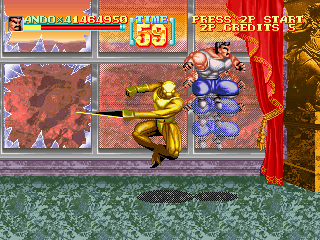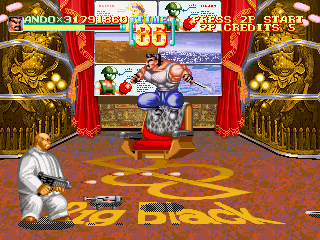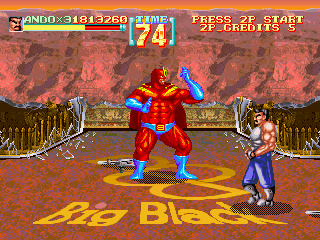Nekketsu Oyako
From Sega Retro
| Nekketsu Oyako | ||||||||||
|---|---|---|---|---|---|---|---|---|---|---|
| System(s): Sega Saturn | ||||||||||
| Publisher: Technosoft | ||||||||||
| Developer: Technosoft | ||||||||||
| Genre: Fighting Action/Kakutou Action (格闘アクション)[1], Action[2] | ||||||||||
| Number of players: 1-2 | ||||||||||
| ||||||||||
|
Nekketsu Oyako (熱血親子) is a beat-'em-up by Technosoft released for the Sega Saturn in 1995. The game was originally released for the PlayStation in 1994. Neither version was released outside Japan. The title roughly translates to "Burning-Blood Family."
The game is noted for its humorous presentation. For example, one stage takes place inside a whale, and alcoholic beverages (a healing item) can only be consumed by Rando while his two kids get an "adult only" message instead.
Contents
Story
Scientist Saeko Hibino is kidnapped by the Haraguro organization to build a doomsday device. Her husband Rando, a former pro wrestler, their daughter Rio, and Saeko's assistant Toratarou "Tora" Minoru set out to rescue her.
Gameplay
The game is a belt-scrolling beat-'em-up that plays similarly to Final Fight. There are three different characters, each with different strengths and unique special moves. Characters walk with ![]() and
and ![]() and perform a short dash with
and perform a short dash with ![]()
![]() and
and ![]()
![]() or with
or with ![]() +
+![]() and
and ![]() +
+![]() . They move in and out of the plane with
. They move in and out of the plane with ![]() and
and ![]() . They jump with
. They jump with ![]() and can do a double jump with
and can do a double jump with ![]() again with midair. Characters attack with
again with midair. Characters attack with ![]() , which can be done in midair. Like many beat-'em-ups, attacking multiple times in quick succession performs a combo that finishes with a special move that does more damage and knocks down enemies. Attacking while dashing likewise does a special knockdown move; characters can also do a slide with
, which can be done in midair. Like many beat-'em-ups, attacking multiple times in quick succession performs a combo that finishes with a special move that does more damage and knocks down enemies. Attacking while dashing likewise does a special knockdown move; characters can also do a slide with ![]() +
+![]() after dashing. While in the air, they can do a dive move with
after dashing. While in the air, they can do a dive move with ![]() +
+![]() . Characters can grab enemies by holding the D-Pad in the direction of the enemy. While an enemy is grabbed, the character can hit the enemy with
. Characters can grab enemies by holding the D-Pad in the direction of the enemy. While an enemy is grabbed, the character can hit the enemy with ![]() or throw the enemy with
or throw the enemy with ![]() +
+![]() or
or ![]() +
+![]() .
.
Each character has a unique special attack that can be done with ![]() , which attacks and knocks down every enemy on the screen at the cost of some health. Characters also have special moves activated by specific motions, as seen in games such as Street Fighter II or Streets of Rage 3. These moves do considerable damage and do not cost any health. Special moves can be mixed with standard attacks at any time.
, which attacks and knocks down every enemy on the screen at the cost of some health. Characters also have special moves activated by specific motions, as seen in games such as Street Fighter II or Streets of Rage 3. These moves do considerable damage and do not cost any health. Special moves can be mixed with standard attacks at any time.
Stages contain various destructible objects, which often contain items. Characters can pick up items, which include weapons, food, money, and toys, with ![]() when standing over them. Weapons include firearms such as rifles and bazookas, thrown weapons such as knives and chakrams, and bombs. Weapons last for a certain amount of strikes before disappearing. They can be dropped manually with
when standing over them. Weapons include firearms such as rifles and bazookas, thrown weapons such as knives and chakrams, and bombs. Weapons last for a certain amount of strikes before disappearing. They can be dropped manually with ![]() . Food items (such as hamburgers, sushi, and bottles of milk) provide healing. Money (such as coins and gold bars) and toys (such as teddy bear and a Sega Saturn) provide bonus points.
. Food items (such as hamburgers, sushi, and bottles of milk) provide healing. Money (such as coins and gold bars) and toys (such as teddy bear and a Sega Saturn) provide bonus points.
Characters have a health bar that is depleted by enemies and occasional stage hazards such as flames or sawblades. If a character's health bar is emptied, the character loses a life but revives after a moment if the player has credits remaining. Additionally, each stage is timed, and the player loses a life when time runs out. The timer resets when the character revives. Characters are temporarily invincible after reviving or being knocked down. Characters retain their health between stages. The player can set the starting credits in the options, and more credits are earned at 200,000 and 700,000 points. There are four selectable difficulty levels.
The game supports two-player simultaneous cooperative play. The second player can join the game at any time by pressing START . Each player has separate credits and controls a different character.
Characters
Move lists assume the player is facing right. If facing left, ![]() and
and ![]() should be reversed.
should be reversed.
Worlds
| Mega Tokyo 2064 | |
|---|---|
| The Big Wave | |
| Hero Graw Island | |
| Sky Gaia | |
| Big Black | |
Magazine articles
- Main article: Nekketsu Oyako/Magazine articles.
Promotional material
also published in:
- Sega Saturn Magazine (JP) #1995-09: "September 1995" (1995-08-08)[4]
also published in:
- Sega Saturn Magazine (JP) #1995-11: "November 1995" (1995-10-07)[5]
Physical scans
| Sega Retro Average | |||||||||||||||||||
|---|---|---|---|---|---|---|---|---|---|---|---|---|---|---|---|---|---|---|---|
|
| 49 | |
|---|---|
| Based on 3 reviews | |
Technical information
- Main article: Nekketsu Oyako/Technical information.
ROM dump status
| System | Hash | Size | Build Date | Source | Comments | |||||||||
|---|---|---|---|---|---|---|---|---|---|---|---|---|---|---|
| ✔ |
|
511,059,024 | CD-ROM (JP) | T-1802G V1.001 |
References
- ↑ File:NekketsuOyako Saturn JP Box Back.jpg
- ↑ 2.0 2.1 https://sega.jp/fb/segahard/ss/soft_licensee1.html (Wayback Machine: 2020-03-20 23:04)
- ↑ Sega Saturn Magazine, "July 1995" (JP; 1995-06-08), page 147
- ↑ Sega Saturn Magazine, "September 1995" (JP; 1995-08-08), page 19
- ↑ Sega Saturn Magazine, "November 1995" (JP; 1995-10-07), page 17
- ↑ Saturn Fan, "1995 October" (JP; 1995-09-08), page 64
- ↑ Sega Saturn Magazine, "August 1995" (JP; 1995-07-07), page 149
- ↑ Sega Saturn Magazine, "Readers rating final data" (JP; 2000-03), page 17
| Nekketsu Oyako | |
|---|---|
|
Main page | Comparisons | Magazine articles | Reception | Technical information | |
